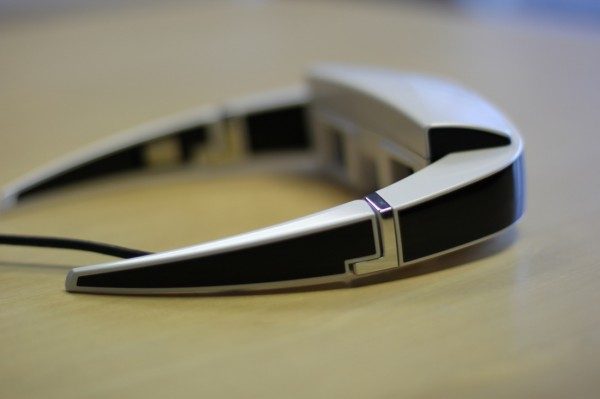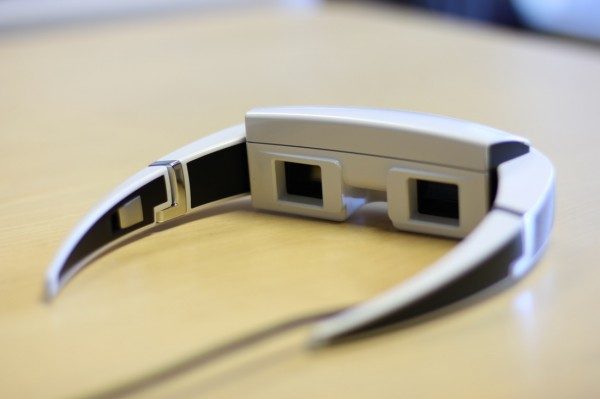 Silicon Micro Display announced the ST1080 head mounted display just a few days back through a press release on the 31st of October. The following day, they dropped dropped most of the specifications for the HMD on their site, including the impressive 10% transparent 1080p LCOS displays. We’re still waiting on the price which is to be announced on 12/1/11, but to whet your appetite, here is a gallery of early photos courtesy of the company’s website, as well as a full rundown of the specs of Silicon Micro Display’s ST1080 HMD.
Silicon Micro Display announced the ST1080 head mounted display just a few days back through a press release on the 31st of October. The following day, they dropped dropped most of the specifications for the HMD on their site, including the impressive 10% transparent 1080p LCOS displays. We’re still waiting on the price which is to be announced on 12/1/11, but to whet your appetite, here is a gallery of early photos courtesy of the company’s website, as well as a full rundown of the specs of Silicon Micro Display’s ST1080 HMD.
Display (x2):
- Resolution: 1920 x 1080 native
- Aspect Ratio: 16:9
- Display Type: 0.74 inch LCoS (Liquid Crystal on Silicon)
- Brightness: 120 cd/m2 (nits)
- Contrast: 1200 at f/2.8
- 10% transparent
Viewing and Audio:
- 2D and 3D-ready
- 45 degrees diagonal field of view
- 100 inches at 10 feet (at 3 m) virtual image
- 240 fps sequential color (80 fps per color)
- 100:1 contrast ratio
- 30 bit RGB color depth (24 bit RGB input)
- 24 bit stereo audio
Size and Weight:
- Goggle
- 6.3 ounces (180 grams)
- 7.1″ x 1.8″ x 7.1″ (180mm x 45mm x 180mm)
- Controller
- 5.6 ounces (160 grams)
- 4.7″ x 2.8″ x 0.6″ – (120mm x 70mm x 15mm)
Power:
- 7 Watts
- USB powered
- 5 hour mobile battery pack
- AC adapter
Inputs and Outputs:
- HDMI Type A and Type D inputs
- 3.5mm stereo audio input
- HMD output
Contents:
- Head-mounted display unit
- Controller unit
- HMD cable
- USB power cable
The ST1080 (180 grams / 0.37 lbs) weights only 28% as much as Sony’s HMZ-T1 (420 grams / 0.93 lbs) [Sony HMZ-T1 specs for comparison]. While that might make it sound like the ST1080 will be far more comfortable than the HMZ-T1, this may not be the case. The ST1080 doesn’t appear to have a very ergonomically designed nose-bridge:
It’s clear the Silicon Micro Display went for comfort-through-weight, while Sony’s approach was comfort-through-structure. We won’t know which is actually the most comfortable for extended HMD viewing until someone gets their hands on both to try! Next week my local Sony store ought to have a pair of HMZ-T1s to try, and I’ll be reporting with my experiences here.
We’ll be watching carefully for the ST1080 price, and we’re hoping that it comes in under $400. The press release points out that companies like MyVu, Vuzi, and eMagin have been in the HMD market before Silicon Micro Display, but failed to find any adoption because of high prices and low-resolution displays. According to the ST1080 press release, Silicon Micro Display “addresses both issues”, which means we can at least hope for a reasonable price. Stay tuned.








Pingback: ST1080 HMD Development Kit on Sale and Retail Model Available for Pre-order in December « Road to Virtual Reality()
Pingback: Sony HMZ-T1 vs. Silicon Micro Display ST1080 HMD Comparison « Road to Virtual Reality()
Pingback: ST1080 Head Mounted Display to be Shown Off at CES 2012 by Silicon Micro Display « Road to Virtual Reality()
Pingback: ST1080 and ST1080 DDK Head Mounted Display Pricing Announced « Road to Virtual Reality()
Pingback: ST1080 Head Mounted Display Starts Pre-orders on March 1st, $100 Discount for Early Adopters « Road to Virtual Reality()
Pingback: Road to VR is 3 Years Old, We Take a Look Back - Road to Virtual Reality()